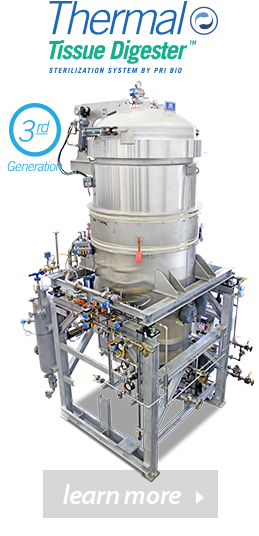Carcass Treatment Methods Compared

 Carcass Treatment System Principles:
Carcass Treatment System Principles:
 Achieve Destruction & Sterilization:
Achieve Destruction & Sterilization:
Utilize temperature, pressure, and agitation to break down material, while ensuring that sterilization is achieved throughout the entirety of the material.
 Operate Efficiently in a Closed System:
Operate Efficiently in a Closed System:
Contain all material within the contents of the processing vessel – no circulation outside. Efficiently utilize resources, including natural gas, water, and electricity.
 Limit Material Handling Post-Treatment:
Limit Material Handling Post-Treatment:
Once the material is processed and treated, the material handling should be minimal or non-existent, and should not require additional processing or treatment elsewhere.
 Ease of Validation:
Ease of Validation:
Validation of the system should be able to be done through proven methods, such as the placement of bio-indicators within the material prior to treatment.
Definitions and Comparison: Our Scorecard
Composting: making a heap of wet organic matter and waiting for the materials to break down over time. The process is aided by shredding and ensuring proper aeration by regularly turning the mixture. Worms and fungi break up the material.
|
|
||
|
|
|||
| Renderers: an apparatus which is used to process animal tissue into more useful materials, typically for purified fats like lard or grease. The rendering process simultaneously dries the material and separates the fat from the bone and protein. Byproducts are then collected and incinerated. |
|
|
|
|
|
|||
| Incineration: a gas-powered furnace, typically used and designed for industrial waste, which burns at very high temperature, reducing its contents to ash. Ash is then collected and disposed of as municipal waste. |
|
|
|
|
|
|||
 |
Alkaline Hydrolysis (Gen 2): tissue is placed in a vessel that is then filled with a mixture of water and lye, and heated to a temperature around 150 °C (302 °F), at a high pressure. The tissue is broken down, and bones are collected while the liquid is disposed of as sanitary municipal waste. |
|
|
|
|
|||
 |
|
|
|
Definitions and Comparison: The Scorecard
|
|
|
|
|
||
|
|
|
|
|
||
|
|
|
|
|
||
Alkaline Hydrolysis (Gen 2): tissue is placed in a vessel that is then filled with a mixture of water and lye, and heated to a temperature around 150 °C (302 °F), at a high pressure. The tissue is broken down, and bones are collected while the liquid is disposed of as sanitary municipal waste. |
|
|
|
|
||
|
|
|
Categories & Tags
ISO 9001:2015
